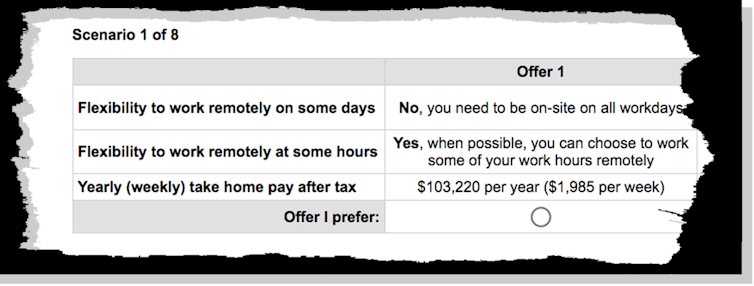A significant proportion of Australian workers – about one-fifth – would be prepared to sacrifice between 16% and 33% of their salaries for the right to work from home, which works out at A$12,000 to $24,000 of those workers’ salaries.
But a much larger proportion, more than one half, would be prepared to sacrifice nothing, being either not strongly convinced about the benefits of working from home or actively preferring to go into the workplace.
Surprisingly, our findings are consistent with those of other surveys conducted both during and before the pandemic, suggesting the widespread move to working from home during COVID hasn’t changed preferences.
Before COVID, on the day of the 2016 Australian census, only 2% to 8% of the workforce in major Australian cities worked from home.
During COVID, on the day of the 2021 census 21% worked from home. A Bureau of Statistics survey conducted amid lockdowns in late 2020 found 31% worked from home most days.
Our survey of 1,113 workers from Australia’s 17 largest urban areas was limited to those in jobs whose tasks could be done either remotely or in central locations.
What we found
We offered the workers surveyed a choice of eight job arrangements with different salary ranges calculated with reference to their current salaries, and different degrees of flexibility about working from home.

We also asked about attitudes to remote working, experience with remote working, commute patterns and age, gender, education and household size.
We found most workers – 55% – weren’t prepared to sacrifice salary for the right to work remotely. Most of these (31% of all workers) didn’t see significant benefits to working from home.
But a substantial proportion, 23.5% of all workers, while seeing benefits to their productivity and health and wellbeing from working from home, were concerned about what it would do to their organisational relationships, learning opportunities and prospects for advancement.
Interestingly, workers who had the most experience of working from home before the pandemic raised these concerns most often. Workers with the least experience of working from home pre-pandemic were the least likely to be concerned about its impact on their careers and work relationships.
This might be because before the pandemic we didn’t have great work-from-home policies and procedures to support remote workers.
Read more: Remote working improves the lives of female managers - but at a cost
Gender matters, age matters
Women valued the ability to work from home far more than men, on average 28% more. This indicates that women are more likely to make a trade-off between long-term career prospects and the benefits of flexible work.
In terms of age, workers in their 30s and 50s valued the ability to work from home the most while workers in their 20s valued it the least. This might be because workers in their 20s at the start of their careers are the most likely to value direct interactions with their colleagues and supervisors.
Knowledge workers value remote work the most
Middle and high-income earners in white-collar “knowledge economy” jobs were the most likely to value working from home. They were willing to forgo $12,000 to $24,000 of their annual salary to have the ability to do it some of the time.
Workers in low-wage clerical or administrative jobs in sectors such as retail and training were among the least likely to value working from home. They were also among the most concerned about its impacts on their relationships with colleagues and opportunities for learning and advancement.
Workers in small firms also placed low values on the ability to work from home, perhaps because these firms lacked the technological capacity to fully support it.
Read more: The shift to working from home will be difficult to reverse
Opinions split on productivity
About half of the workers surveyed thought they were less productive at home. About another quarter found no impact. The final quarter found a significant improvement in both the quality and quantity of their work.
Many said that while their working from home might cut the amount they got done per hour, it didn’t cut the total amount they got done because the flexibility it offered allowed them to catch up at other times.
High and medium-wage professionals were the most optimistic about their productivity at home, and workers in low and medium-wage service jobs the least optimistic – a pattern that mirrored what they were prepared to sacrifice for the right to work at home.
How to become an employer of choice
Our findings suggest many employers of knowledge economy workers might be able to attract and retain high-quality staff by offering the ability to work from home in lieu of higher salaries.
But this will not be the answer for all employers looking to retain the best staff.
With many workers wary of what could happen to their career prospects if they stayed at home, and 55% of workers placing no value on remote work, some employers will need to find other ways to attract the best workers.
Many workers value both face-to-face relations and flexibility. Finding the right balance will become increasingly important now that COVID has shown us how many of our jobs can be done from home.

